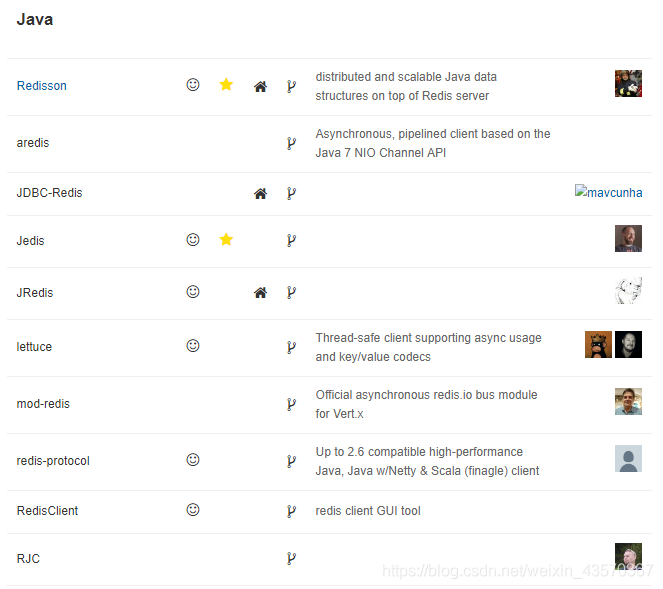转自:https://blog.csdn.net/weixin_43570367/article/details/104248599
使用 Java 操作 Redis 的方案很多,Jedis 是目前较为流行的一种方案,除了 Jedis ,还有很多其他解决方案,如下:

除了这些方案之外,还有一个使用也相当多的方案,就是 Spring Data Redis。
在传统的 SSM 中,需要开发者自己来配置 Spring Data Redis ,这个配置比较繁琐,主要配置 3 个东西:连接池、连接器信息以及 key 和 value 的序列化方案。
在 Spring Boot 中,默认集成的 Redis 就是 Spring Data Redis,默认底层的连接池使用了 lettuce ,开发者可以自行修改为自己的熟悉的,例如 Jedis。
Spring Data Redis 针对 Redis 提供了非常方便的操作模板 RedisTemplate 。这是 Spring Data 擅长的事情,那么接下来我们就来看看 Spring Boot 中 Spring Data Redis 的具体用法。
创建工程
创建工程,引入 Redis 依赖:

创建成功后,还需要手动引入 commos-pool2 的依赖,因此最终完整的 pom.xml 依赖如下:
<dependencies>
<dependency>
<groupId>org.springframework.boot</groupId>
<artifactId>spring-boot-starter-data-redis</artifactId>
</dependency>
<dependency>
<groupId>org.springframework.boot</groupId>
<artifactId>spring-boot-starter-web</artifactId>
</dependency>
<dependency>
<groupId>org.apache.commons</groupId>
<artifactId>commons-pool2</artifactId>
</dependency>
</dependencies>
这里主要就是引入了 Spring Data Redis + 连接池。
配置 Redis 信息
接下来配置 Redis 的信息,信息包含两方面,一方面是 Redis 的基本信息,另一方面则是连接池信息:
spring.redis.database=0
spring.redis.password=123
spring.redis.port=6379
spring.redis.host=192.168.66.128
spring.redis.lettuce.pool.min-idle=5
spring.redis.lettuce.pool.max-idle=10
spring.redis.lettuce.pool.max-active=8
spring.redis.lettuce.pool.max-wait=1ms
spring.redis.lettuce.shutdown-timeout=100ms
另外一个参考
#Matser的ip地址
redis.hostName=192.168.177.128
#端口号
redis.port=6382
#如果有密码
redis.password=
#客户端超时时间单位是毫秒 默认是2000
redis.timeout=10000
#最大空闲数
redis.maxIdle=300
#连接池的最大数据库连接数。设为0表示无限制,如果是jedis 2.4以后用redis.maxTotal
#redis.maxActive=600
#控制一个pool可分配多少个jedis实例,用来替换上面的redis.maxActive,如果是jedis 2.4以后用该属性
redis.maxTotal=1000
#最大建立连接等待时间。如果超过此时间将接到异常。设为-1表示无限制。
redis.maxWaitMillis=1000
#连接的最小空闲时间 默认1800000毫秒(30分钟)
redis.minEvictableIdleTimeMillis=300000
#每次释放连接的最大数目,默认3
redis.numTestsPerEvictionRun=1024
#逐出扫描的时间间隔(毫秒) 如果为负数,则不运行逐出线程, 默认-1
redis.timeBetweenEvictionRunsMillis=30000
#是否在从池中取出连接前进行检验,如果检验失败,则从池中去除连接并尝试取出另一个
redis.testOnBorrow=true
#在空闲时检查有效性, 默认false
redis.testWhileIdle=true
#redis集群配置
spring.redis.cluster.nodes=192.168.177.128:7001,192.168.177.128:7002,192.168.177.128:7003,192.168.177.128:7004,192.168.177.128:7005,192.168.177.128:7006
spring.redis.cluster.max-redirects=3
#哨兵模式
#redis.sentinel.host1=192.168.177.128
#redis.sentinel.port1=26379
#redis.sentinel.host2=172.20.1.231
#redis.sentinel.port2=26379
自动配置
当开发者在项目中引入了 Spring Data Redis ,并且配置了 Redis 的基本信息,此时,自动化配置就会生效。
我们从 Spring Boot 中 Redis 的自动化配置类中就可以看出端倪:
@Configuration
@ConditionalOnClass(RedisOperations.class)
@EnableConfigurationProperties(RedisProperties.class)
@Import({ LettuceConnectionConfiguration.class, JedisConnectionConfiguration.class })
public class RedisAutoConfiguration {
@Bean
@ConditionalOnMissingBean(name = "redisTemplate")
public RedisTemplate<Object, Object> redisTemplate(
RedisConnectionFactory redisConnectionFactory) throws UnknownHostException {
RedisTemplate<Object, Object> template = new RedisTemplate<>();
template.setConnectionFactory(redisConnectionFactory);
return template;
}
@Bean
@ConditionalOnMissingBean
public StringRedisTemplate stringRedisTemplate(
RedisConnectionFactory redisConnectionFactory) throws UnknownHostException {
StringRedisTemplate template = new StringRedisTemplate();
template.setConnectionFactory(redisConnectionFactory);
return template;
}
}
这个自动化配置类很好理解:
- 首先标记这个是一个配置类,同时该配置在 RedisOperations 存在的情况下才会生效(即项目中引入了 Spring Data Redis)
- 然后导入在 application.properties 中配置的属性
- 然后再导入连接池信息(如果存在的话)
- 最后,提供了两个 Bean ,RedisTemplate 和 StringRedisTemplate ,其中 StringRedisTemplate 是 RedisTemplate 的子类,两个的方法基本一致,不同之处主要体现在操作的数据类型不同,RedisTemplate 中的两个泛型都是 Object ,意味者存储的 key 和 value 都可以是一个对象,而 StringRedisTemplate 的 两个泛型都是 String ,意味者 StringRedisTemplate 的 key 和 value 都只能是字符串。如果开发者没有提供相关的 Bean ,这两个配置就会生效,否则不会生效。
使用
接下来,可以直接在 Service 中注入 StringRedisTemplate 或者 RedisTemplate 来使用:
@Service
public class HelloService {
@Autowired
RedisTemplate redisTemplate;
public void hello() {
ValueOperations ops = redisTemplate.opsForValue();
ops.set("k1", "v1");
Object k1 = ops.get("k1");
System.out.println(k1);
}
}
Redis 中的数据操作,大体上来说,可以分为两种:
- 针对 key 的操作,相关的方法就在 RedisTemplate 中
- 针对具体数据类型的操作,相关的方法需要首先获取对应的数据类型,获取相应数据类型的操作方法是 opsForXXX
调用该方法就可以将数据存储到 Redis 中去了,如下:
k1 前面的字符是由于使用了 RedisTemplate 导致的,RedisTemplate 对 key 进行序列化之后的结果。
RedisTemplate 中,key 默认的序列化方案是 JdkSerializationRedisSerializer 。
而在 StringRedisTemplate 中,key 默认的序列化方案是 StringRedisSerializer ,因此,如果使用 StringRedisTemplate ,默认情况下 key 前面不会有前缀。
不过开发者也可以自行修改 RedisTemplate 中的序列化方案,如下:
@Service
public class HelloService {
@Autowired
RedisTemplate redisTemplate;
public void hello() {
redisTemplate.setKeySerializer(new StringRedisSerializer());
ValueOperations ops = redisTemplate.opsForValue();
ops.set("k1", "v1");
Object k1 = ops.get("k1");
System.out.println(k1);
}
}
当然也可以直接使用 StringRedisTemplate:
@Service
public class HelloService {
@Autowired
StringRedisTemplate stringRedisTemplate;
public void hello2() {
ValueOperations ops = stringRedisTemplate.opsForValue();
ops.set("k2", "v2");
Object k1 = ops.get("k2");
System.out.println(k1);
}
}




















 8529
8529











 被折叠的 条评论
为什么被折叠?
被折叠的 条评论
为什么被折叠?








